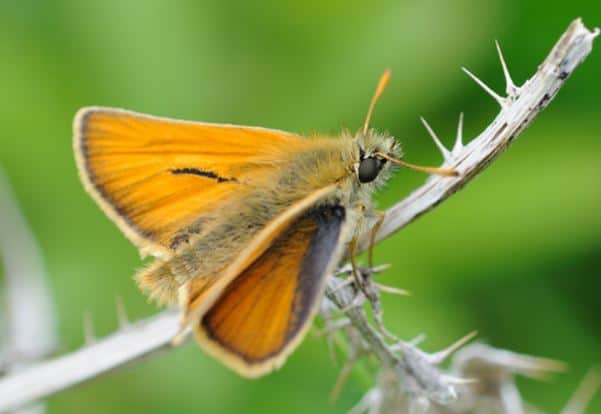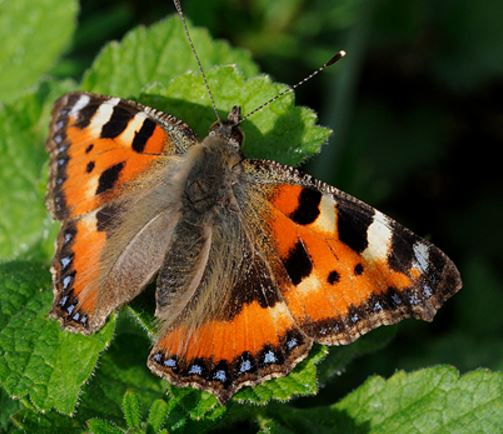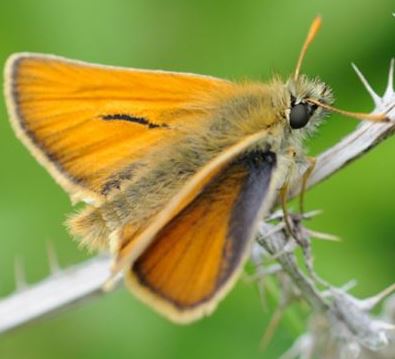The butterfly population has declined alarmingly, partly because of neonicotinoid pesticide usage, a UK study has found. Neonicotinoid pesticides are a class of neuro-active insecticides that chemically are very similar to nicotine. The neonicotinoid family includes acetamiprid, nitenpyram, thiamethoxam, clothianidin, imidacloprid, nithiazine and thiacloprid. Imidacloprid is the most widely used pesticide (insecticide) in the world.
According to prior studies, neonicotinoid pesticide usage has been harming many different species of wildlife, including bees and birds.
A team of researchers from the Universities of Stirling and Sussex, Butterfly Conservation and the Centre for Ecology and Hydrology, explained in the journal PeerJ that their study was the first to have clear scientific evidence showing a likely link between declining British butterfly populations and neonicotinoid pesticide use.
 Small Skipper (Thymelicus sylvestris) – one of the 15 species shown to be affected by neonicotinoid pesticide use. Colonies can be found in the UK where grasses are allowed to grow tall and lush. (Image: britishbutterflies.co.uk)
Small Skipper (Thymelicus sylvestris) – one of the 15 species shown to be affected by neonicotinoid pesticide use. Colonies can be found in the UK where grasses are allowed to grow tall and lush. (Image: britishbutterflies.co.uk)
Neonicotinoids accumulate in wild flowers
Neonicotinoid pesticides stay in the environment and are absorbed by wild flowers that grow in field margins. A field margin is an area between the crop and the field boundary – it provides a vital habitat for several wildlife species, including grasses and wildflowers, where insects and birds feast on their plentiful seeds and nectar.
For British butterflies and caterpillars, field margins are a vital source of nectar.
Butterfly Conservation explains that neonicotinoid pesticides were first used in the mid-1990s to replace older insecticides. They are systematic insecticides; this means that they are absorbed by every single cell in the plant, thus making all its parts poisonous to insects.
Fifteen butterfly species harmed by neonicotinoid pesticides
Professor of Biology at the University of Sussex, Dave Goulson, and team found that the population trends of 15 butterfly species showed declines associated with neonicotinoid pesticide usage, including the Small Tortoiseshell, Small Skipper and Wall Brown species.
This latest study is based on data that volunteers collected from over 1,000 sites across Britain as part of the UK Butterfly Monitoring Scheme (UKBMS), which has monitored changes in the abundance of butterflies throughout the UK since 1976.
 The Small Tortoiseshell (Aglais urticae L.) – also found to be affected by neonicotinoid pesticide. This species is commonly found in gardens, feeding on Buddleia. (Image: britishbutterflies.co.uk)
The Small Tortoiseshell (Aglais urticae L.) – also found to be affected by neonicotinoid pesticide. This species is commonly found in gardens, feeding on Buddleia. (Image: britishbutterflies.co.uk)
Professor Goulson said:
“Many of us can remember a time when our meadows and hedgerows had far more butterflies, bees and other insects than today. This study adds to the growing mountain of evidence that neonicotinoids are one of the causes of these declines.”
Insecticide impact on several species likely to be huge
Dr. Andre Gilburn, an ecologist at the University of Stirling, who led the study, said:
“Our study not only identifies a worrying link between the use of neonicotinoids and declines in butterflies, but also suggests that the strength of their impact on many species could be huge.”
 The Wall Brown (Lasiommata megera) – also identified as badly affected by neonicotinoid pesticides – can be found in short grassland where the turf is bare broken or stony. It is more common on dunes and other coastal habitats. (Image: britishbutterflies.co.uk)
The Wall Brown (Lasiommata megera) – also identified as badly affected by neonicotinoid pesticides – can be found in short grassland where the turf is bare broken or stony. It is more common on dunes and other coastal habitats. (Image: britishbutterflies.co.uk)
Dr. Tom Brereton, head of monitoring at Butterfly Conservation, commented:
“We are extremely concerned with the findings of the study and are calling for urgent research to see whether the correlations we found are caused by neonicotinoid use, or some other aspect of intensive farming.”
“Widespread butterflies have declined by 58 percent on farmland in England over the last 10 years, giving concern for the general health of the countryside and for these and other insects in particular.”
Reference: “Are neonicotinoid insecticides driving declines of widespread butterflies?” Nils Bunnefeld, Andre S. Gilburn, John McVean Wilson, Tom M. Brereton, Marc S. Botham, Richard Fox and Dave Goulson. 24th November, 2015. PeerJ 3:e1402. https://dx.doi.org/10.7717/peerj.1402.
Video – Spotting and Identifying British Butterflies
In this video, Matthew Oates, a National Trust Butterfly Specialist, talks about spotting and identifying Britain’s butterflies.

